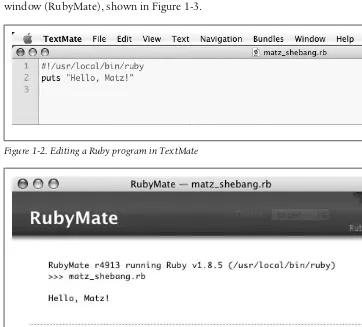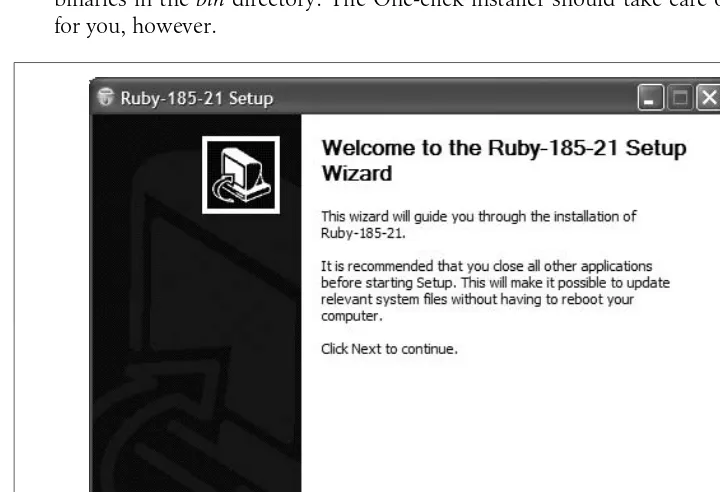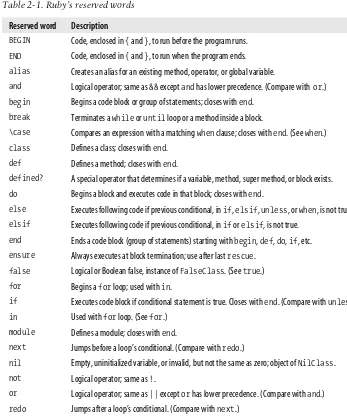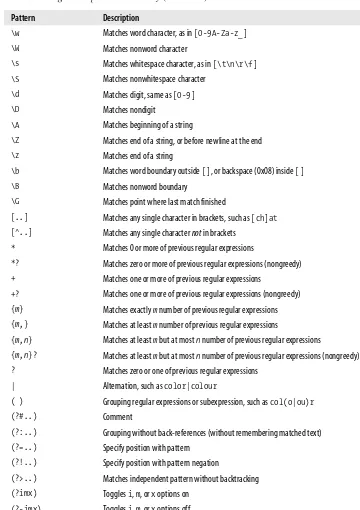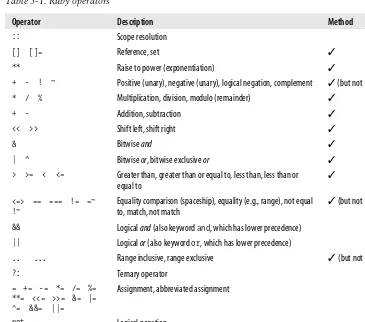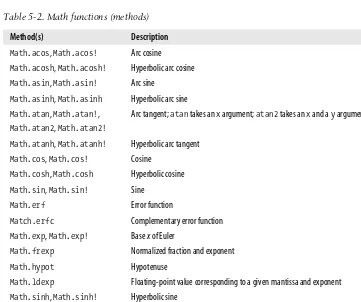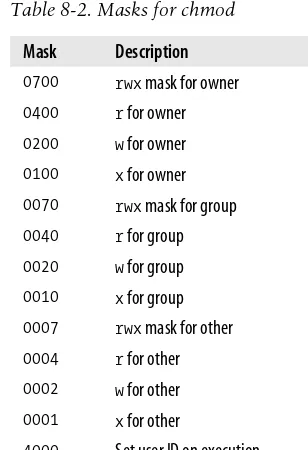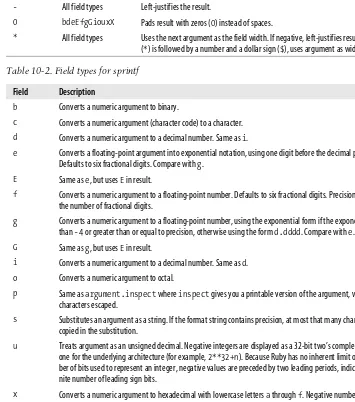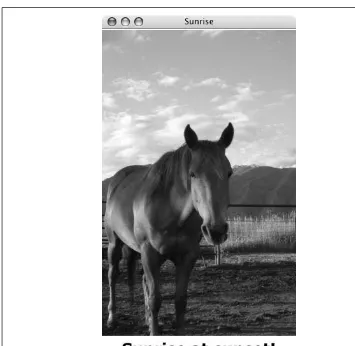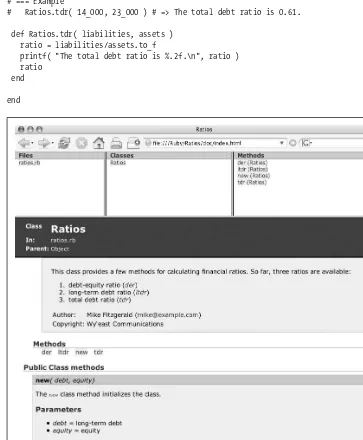Other resources from OâReilly
Related titles Ruby Cookbookâ¢
Ruby in a Nutshell Ruby on Rails: Up and
Running
Ajax on Rails Rails Cookbookâ¢
oreilly.com oreilly.comis more than a complete catalog of OâReilly books. Youâll also find links to news, events, articles, weblogs, sample chapters, and code examples.
oreillynet.comis the essential portal for developers interested in open and emerging technologies, including new platforms, pro-gramming languages, and operating systems.
Conferences OâReilly brings diverse innovators together to nurture the ideas that spark revolutionary industries.We specialize in document-ing the latest tools and systems, translatdocument-ing the innovatorâs knowledge into useful skills for those in the trenches.Visit
conferences.oreilly.com for our upcoming events.
Learning Ruby
Michael Fitzgerald
Learning Ruby
by Michael Fitzgerald
Copyright © 2007 Michael Fitzgerald. All rights reserved. Printed in the United States of America.
Published by OâReilly Media, Inc., 1005 Gravenstein Highway North, Sebastopol, CA 95472. OâReilly books may be purchased for educational, business, or sales promotional use. Online editions are also available for most titles (safari.oreilly.com). For more information, contact our
corporate/institutional sales department: (800) 998-9938 or[email protected].
Editor: Simon St.Laurent
Production Editor: Lydia Onofrei
Proofreader: Lydia Onofrei
Indexer: John Bickelhaupt
Cover Designer: Karen Montgomery
Interior Designer: David Futato
Illustrators: Robert Romano and Jessamyn Read
Printing History:
May 2007: First Edition.
Nutshell Handbook, the Nutshell Handbook logo, and the OâReilly logo are registered trademarks of OâReilly Media, Inc.Learning Ruby, the image of a giraffe, and related trade dress are trademarks of OâReilly Media, Inc.
Many of the designations used by manufacturers and sellers to distinguish their products are claimed as trademarks. Where those designations appear in this book, and OâReilly Media, Inc. was aware of a trademark claim, the designations have been printed in caps or initial caps.
While every precaution has been taken in the preparation of this book, the publisher and author assume no responsibility for errors or omissions, or for damages resulting from the use of the information contained herein.
This book uses RepKoverâ¢, a durable and flexible lay-flat binding.
vii
Table of Contents
Preface
. . . .xi
1. Ruby Basics
. . .1
Hello, Matz 2
Interactive Ruby 12
Resources 13
Installing Ruby 15
Permission Denied 20
Associating File Types on Windows 21
Review Questions 22
2. A Quick Tour of Ruby
. . .23
Ruby Is Object-Oriented 23
Rubyâs Reserved Words 26
Comments 27
Variables 28
Strings 30
Numbers and Operators 33
Conditional Statements 34
Arrays and Hashes 34
Methods 35
Blocks 40
Symbols 43
Exception Handling 44
Ruby Documentation 45
3. Conditional Love
. . .47
The if Statement 47
The case Statement 51
The while Loop 52
The loop Method 55
The for loop 56
Execution Before or After a Program 59
Review Questions 59
4. Strings
. . .60
Creating Strings 60
Concatenating Strings 63
Accessing Strings 63
Comparing Strings 65
Manipulating Strings 66
Case Conversion 70
Managing Whitespace, etc. 71
Incrementing Strings 73
Converting Strings 74
Regular Expressions 74
1.9 and Beyond 78
Review Questions 78
5. Math
. . .79
Class Hierarchy and Included Modules 80
Converting Numbers 81
Basic Math Operations 81
Ranges 85
Inquiring About Numbers 86
More Math Methods 88
Math Functions 88
Rational Numbers 90
Prime Numbers 91
Review Questions 92
6. Arrays
. . .93
Creating Arrays 94
Accessing Elements 97
Table of Contents | ix
Set Operations 99
Unique Elements 100
Blow Your Stack 100
Comparing Arrays 101
Changing Elements 101
Deleting Elements 103
Arrays and Blocks 103
Sorting Things and About Face 104
Multidimensional Arrays 104
1.9 and Beyond 105
Other Array Methods 105
Review Questions 105
7. Hashes
. . .107
Creating Hashes 107
Accessing Hashes 108
Iterating over Hashes 109
Changing Hashes 110
Converting Hashes to Other Classes 113
1.9 and Beyond 113
Other Hash Methods 114
Review Questions 114
8. Working with Files
. . .115
Directories 115
Creating a New File 117
Opening an Existing File 117
Deleting and Renaming Files 120
File Inquiries 120
Changing File Modes and Owner 121
The IO Class 123
Review Questions 124
9. Classes
. . .125
Defining the Class 126
Instance Variables 127
Accessors 129
Class Variables 130
Inheritance 133
Modules 134
public, private, or protected 137
Review Questions 138
10. More Fun with Ruby
. . .139
Formatting Output with sprintf 139 Processing XML 142 Date and Time 147 Reflection 151 Using Tk 154 Metaprogramming 157 RubyGems 158 Exception Handling 162 Creating Documentation with RDoc 164 Embedded Ruby 171 Review Questions 174
11. A Short Guide to Ruby on Rails
. . .175
Where Did Rails Come From? 175 Why Rails? 176 What Have Other Folks Done with Rails? 180 Hosting Rails 182 Installing Rails 182 Learning Rails 185 A Brief Tutorial 186 Review Questions 193
A. Ruby Reference
. . .195
B. Answers to Review Questions
. . .214
Glossary
. . .219
xi
Preface
1Ruby has gotten a lot of attention since the appearance of Ruby on Rails, the web application framework written in Ruby.The attention is way past due.Ruby has been around as long as Java but enjoyed only limited attention outside of Japan until around 2000.In the last few years, Rubyâs popularity has steadily grown, and with good reason.
Who Should Read This Book?
Generally, I figure two kinds of readers will buy this book: experienced program-mers who want to learn Ruby, and new programprogram-mers who want to learn to program. I have the interesting job of catering to both while trying not to tick off either.Itâs a balancing act, and this is how Iâll handle it: I am going to address you as if you are already a competent programmer, but Iâll also provide plenty of help for beginners, mostly in the form of notes or sidebars.Iâll let you know when you can skip a sec-tion if you are already a heavy hitter.
If youâre a fairly experienced programmer, you might just want to read the code examples first, from the beginning of the book to the end, skimming the explana-tions surrounding the examples as needed.You should be able to see whatâs going on fairly quickly just by keeping your eyes on the code.The code is laid out in a more or less logical fashion (to me at least), so you should be able to figure out Ruby in fairly short order.If you are new to programming, I have attempted to make your job a little easier by explaining things as I go along.
How This Book Works
Itâs the same with programming in a new language.I am going to show you lots of Ruby programs, many of them just one-liners, and then tell you how and why they workâjust enough to get you rolling down the road.I take this approach because I believe we do most of our learning by observing, imitating, and playing.I plan to do a lot of that in this book.
You should know up front that this is a just-get-in-and-drive book.In other words, you can drive a car even if you donât know whether its got six or eight cylinders. David Heinemeier Hansson, inventor of Ruby on Rails, said something I like: âPeo-ple learn by changing a little thing, reloading, and seeing the change.â Heâs right on. Thatâs my experience: over the years I have learned more by hacking code than by reading about it.
I also move as quickly as possible, not getting bogged down in the quicksand of details.The details will come in time, as they are needed; the main thing I want to give you now is forward movement and momentum.
If you just follow along with what Iâm doing, running the programs and altering them to your taste, youâll learn quickly.The more you run these programs, the more fluency youâll develop, and before long, youâll start thinking and even dreaming in Ruby. Then youâll just take off on your own.
The latest stable version at the time I am writing this is 1.8.6. Thatâs the version Iâll be using.You can probably get along using an older version, but unless you have 1.8.6 or later installed, I canât guarantee that all the programs in this book will work as advertised, though they most likely will.
About the Examples
I think we learn best by observing what others do, then imitating what we observe. Thatâs how we learn as children, anyway.And thatâs why youâll find code exam-plesâto observe and imitateâon nearly every page of this book.
Many of the examples are available for download from http://www.oreilly.com/ catalog/9780596529864.The idea is that you will have enough examples in your hands to start most of the basic programming tasks.
How This Book Is Organized
Learning Ruby is organized into 11 chapters. A brief synopsis of each follows: Chapter 1,Ruby Basics
Preface | xiii Chapter 2,A Quick Tour of Ruby
Gallops over the Ruby terrain at a brisk pace, covering briefly the most impor-tant features of Ruby.
Chapter 3,Conditional Love
Explains and demonstrates how to use conditionals (likeifandwhile) in Ruby, including looping mechanisms.
Chapter 4,Strings
Introduces how to manipulate strings in Ruby (includes a section on regular expressions).
Chapter 5,Math
Shows you how to use operators, basic math functions, functions from theMath
module, rational numbers, etc. Chapter 6,Arrays
Talks you through Ruby arrays. Chapter 7,Hashes
Demonstrates hashes in detail. Chapter 8,Working with Files
Reveals how to process files with Ruby, including reading and writing files, and so on.
Chapter 9,Classes
Discusses Ruby classes in detail, including a tiny introduction to object-oriented programming (OOP), instance variables, instance methods, class variables, class methods, modules, and mixins.
Chapter 10,More Fun with Ruby
Introduces a variety of topics of interest, including RubyGems, reflection, metaprogramming, exception handling, and more.
Chapter 11,A Short Guide to Ruby on Rails
Gets you acquainted with some of the essentials of Rails and includes a short tutorial.(You have to give credit to Ruby on Rails for improving the visibility of Ruby.)
Appendix A,Ruby Reference
Presents all the reference material from the book in one location. Appendix B,Answers to Review Questions
Provides answers to the review questions found at the end of the chapters (more than 100 questions and answers).
Glossary
Conventions Used in This Book
The following font conventions are used in this book:Italic is used for:
⢠Pathnames and filenames (such as program names) ⢠Internet addresses, such as domain names and URLs ⢠New terms where they are defined, or for emphasis
Constant width is used for:
⢠Command lines and options that should be typed verbatim in a file or inirb
⢠Names and keywords in Ruby programs, including method names, variable names, and class names
Constant width italic is used for: ⢠User-supplied values
Constant width bold is used to:
⢠Draw attention to parts of programs
This icon indicates a tip, suggestion, or general note.
This icon indicates a warning or caution.
Comments and Questions
Please address comments and questions concerning this book to the publisher: OâReilly Media, Inc.
1005 Gravenstein Highway North Sebastopol, CA 95472
800-998-9938 (in the United States or Canada) 707-829-0515 (international or local)
707-829-0104 (Fax)
There is a web page for this book, which lists errata, examples, or any additional information. You can access this page at:
Preface | xv To comment or ask technical questions about this book send email to:
For more information about books, conferences, Resource Centers, and the OâReilly Network, see the OâReilly web site at:
http://www.oreilly.com
Safari® Enabled
When you see a Safari® Enabled icon on the cover of your favorite tech-nology book, that means the book is available online through the OâReilly Network Safari Bookshelf.
Safari offers a solution thatâs better than e-books.Itâs a virtual library that lets you easily search thousands of top tech books, cut and paste code samples, download chapters, and find quick answers when you need the most accurate, current informa-tion. Try it for free athttp://safari.oreilly.com.
Acknowledgments
Once again, I want to thank my editor Simon St.Laurent for giving me the chance to write this book.Simonâs encouragement has kept me afloat through four book projects!
I also appreciate the comments from the technical reviewers Ryan Waldron and Joey Franklin.They hauled me back on deck when I was floundering in heavy seas. Thanks, guys.
1
Chapter 1
CHAPTER 1
Ruby Basics
1Perhaps like you, Iâve learned to program in a number of languages over the yearsâ BASIC, FORTRAN, C, C++, C#, Java, and JavaScript among othersâbut so far Ruby is my favorite.It has been the most fun to learn and use.Why? Because of its syntax.If you have a background in a variety of other languages, Ruby is easy to fig-ure out.And itâs flexible: Ruby lets you do things in a variety of ways, not just one way, so you can decide how to do thingsyour way.
Ruby is an interpreted rather than a compiled language.You can call it a scripting language, an object-oriented language, a refreshing language.Itâs not a perfect lan-guage.It doesnât have to be.Itâs still my favorite.It has that certainje ne sais quoi.If it didnât, why would I spend hundreds of hours writing a book about it? Certainly not for money and fame.
To me, one of the best aspects of Ruby is its composability.Composabilityis the degree to which you can express logic by combining and recombining parts of a language (see James Clarkâs âThe Design of RELAX NGâ athttp://www.thaiopensource.com/relaxng/ design.html#section:5). Rubyâs got that, big time.
Also, Ruby isn't under committee or corporate control.Itâs open source.It was writ-ten by Matz, with some help from his friends.(It was writwrit-ten in C, by the way, and can take C extensions.)
âMatzâ is short for Yukihiro Matsumoto (from Japan).He started working on Ruby in 1993, and first released it to the world in 1995, the same year Java came out.It took a while for Ruby to emerge in the West, but once it did, around the year 2000, it started to take off.With the help of people like Dave Thomas, Andy Hunt, Hal Fulton, and others, Ruby got a foothold. Now it has a fan base.
Hello, Matz
I know many readers are expecting a âHello, Worldâ example right about now.In spite of a moral and ethical obligation to provide a âHello, Worldâ example, I have decided to change the first example to âHello, Matz.â Given all that Matz has done for the programming world, donât you think he deserves some acknowledgment? Before you go any further, find out if you already have Ruby installed on your com-puter.If you are on Mac OS X or a Linux distribution of some sort, it might already be there, though itâs probably an older version; Tiger (Mac OS X 10.4 or later) ships with version 1.8.2, for example.
To discover if Ruby is lurking inside your box, just go to a shell prompt on a Unix/ Linux system (this wonât work on a standard Windows system) and type:
$ which ruby
See if you get a reply like this one (good news if you do):
/usr/local/bin/ruby
Or just type a command to check the version of Ruby (this works on Unix/Linux and Windows):
$ ruby -v
or:
$ ruby --version
If Ruby is installed, you should get an answer that looks like this:
ruby 1.8.6 (2007-03-13 patchlevel 0) [powerpc-darwin8.9.0]
If Ruby is not installed on your box, and youâre a little nervous about figuring out how to install it on your own, go to the section âInstalling Ruby,â later in this chapter.Follow the instructions there to install Ruby on your platform. Then come right back!
A Very Short Ruby Program
Now that you have Ruby up and running, type the following line in a plain-text editor such as TextPad or vim:
puts "Hello, Matz!"
This line of code is a programmingstatement, an instruction that you want the pro-gram to carry out.The instruction will print the stringHello, Matz! on your screen, followed by a newline character.
You can end a statement with a semicolon (;) if you want, just like in C or Java, but you sure donât have to: a newline will do fine.(Most Ruby programmers donât use;
Hello, Matz | 3 Save the little program in a file as plain text and name itmatz.rb.(The.rbfile exten-sion is the conventional extenexten-sion for Ruby programs.)
Itâs a good idea to save the file in a directory or folder where you plan to do your Ruby work so that all your Ruby files will be readily acces-sible in one location.
You run the program by running the Ruby interpreter.To do this, type the following at a shell or command prompt:
$ ruby matz.rb
The output from the program is displayed by default on the screen:
Hello, Matz!
Placing a# at the beginning of a line tells the interpreter to ignore that line:
# a nice greeting for Matz puts "Hello, Matz!"
Add the#and some text following it to your programmatz.rb.This is called a com-ment.Whatever follows the#is hidden from the Ruby interpreter.Youâll learn more about comments in Chapter 2.
Shebang!
If you run a Ruby program on Windows, you generally have to use the ruby com-mand before the Ruby filename (unless you associate the file extension.rbwith a file type; to learn how to do this, see âAssociating File Types on Windows,â later in this chapter).You can avoid typing ruby each time on Unix/Linux systems by adding something called a shebang line (#!) at the top of your Ruby file.Add a shebang line to the top ofmatz.rb:
#!/usr/local/bin/ruby # a nice greeting for Matz puts "Hello, Matz!"
The shebang lets the system know where to find the Ruby interpreter, that is, in/usr/ local/bin, which is a conventional place to install Ruby executables (see âInstalling Ruby on Mac OS X Tiger,â later in this chapter).A more general alternative is#!/usr/ bin/env ruby. Choose what works for you. I use the latter.
As mentioned earlier, Tiger comes installed with an older version of Ruby, version 1.8.2, which is stored in /usr/bin.We wonât bother using that version.
Go to a prompt on your Mac or Unix/Linux system and enter the filename by itself:
Youâll get the same answer as before:
Hello, Matz!
If you get apermission deniedmessage when runningmatz.rb, and you arenât sure what to do about it, Iâd like to offer you a hand.Go to the section âPermission Deniedâ near the end of this chapter to find out what to do.
Iâll now show you more ways you can output the textHello, Matz!, which will give you a glimpse of the power of Ruby.At this point, I wonât get very deep into detail about whatâs going on.Just follow along, typing in and testing as much code as you want. To test the code, follow these steps.
1.Delete the previous code inmatz.rb. 2.Enter the new code.
3.Run the program with the Ruby interpreter from the prompt to see the output. Youâll be deleting the old code in matz.rb and inserting new code, unless another Ruby file with a different name is presented in the text.You can either recreate these other files with the given names, or you can download all the files that come with this book from http://www.oreilly.com/catalog/9780596529864.After downloading the ZIP archive, extract the files into the directory or folder of your choice.Thatâs where youâll do your work.Navigate to the directory in a shell or command window using thecd command.
Issue a System Command
You can run an operating system command withsystem:
system "echo 'Hello, Matz!'"
Try this with and without single quotes ('), where shown.
You can also submit each part of a command separately, as an argument tosystem:
system "echo", "Hello,", "Matz!"
Theexeccommand is similar tosystem, but it replaces the current process and, after the command is finished, exitsânot always what you want to do.
Appending a String
Append one string to another with the+ method:
puts "Hello, " + "Matz!"
You can also append a string with the<< method:
Hello, Matz | 5
Multiply
What if you want to print out a line of text three times? How about:
puts "Hello, Matz! " * 3
This would give you:
Hello, Matz! Hello, Matz! Hello, Matz!
Or you could use thetimes method:
5.times { print "Hello, Matz! " }
It will show your enthusiasm:
Hello, Matz! Hello, Matz! Hello, Matz! Hello, Matz! Hello, Matz!
You could just print one word three times, then add or append more text with+:
puts "Hello, " * 3 + "Matz!"
Then youâd get:
Hello, Hello, Hello, Matz!
Inserting a Shell Command
Letâs insert some output from a shell command:
puts "Hey Matz, Iâm running " + `ruby --version`
When you run this, the output from the shell command inside the grave accents or backticks (`ruby --version`) is inserted into the output:
Hey Matz, Iâm running ruby 1.8.6 (2006-08-25) [powerpc-darwin8.8.0]
Using a Variable
You can give a value a name by assigning it to a variable:
hi = "Hello, Matz!" puts hi # => Hello, Matz!
hiis an example of alocal variable.You can tell because its name starts with a lower-case letter.Youâll learn more about local and other kinds of variables in Chapter 2 in the section âVariables.â
In code examples, => will always follow a comment character (#). Whatever follows => is the output you can expect from the line or block of code, or from the whole program.
Put two or more variables together with the+ method: hi = "Hello, "
person = "Matz!"
Expression Substitution
Another way of inserting the value of a variable in a string is withexpression substitu-tionâa very handy feature of Ruby:
person = "Matz!"
puts "Hello, #{person}" # => Hello, Matz!
The#{...}is replaced with the result of the expression inside it.For example,#{2+2}
would yield the result4.
Using expression substitution, you can grab an argument off the command line and add it to the output.
#!/usr/bin/env ruby
puts "Hello, #{ARGV[0]}!"
Ruby stores command-line arguments in a predefined Ruby variable called ARGV.
ARGV[0]refers to the first item on the command line, the 0th element inARGV.Run thematz.rb program you just edited with an argument to see the results:
$ matz.rb Matz Hello, Matz!
Formatting a String
You can change the output on the fly with the%s format flag and%:
hi = "Hello, %s"
puts hi % "Matz!" # => "Hello, Matz!"
puts hi % "people!" # => "Hello, people!"
puts hi % "universe!" # => "Hello, universe!"
You can also use% like this:
"%s, %s!" % [ "Hello", "Matz" ]
% is a method from theString class that formats a string. It is like usingsprintf: sprintf( "Hello, %s", "Matz!" ) # => "Hello, Matz!"
Useprintf to print the output to your display (the default standard output device). printf( "Hello, %s", "Matz!" ) # => Hello, Matz!
Hello, Matz | 7
The eval Method and -e Option
The eval method evaluates a string enclosed in quotes as a Ruby statement or expression and returns the result. Itâs handy for testing.
eval "puts 'Hello, Matz!'" # => Hello, Matz!
Similarly, there is a way you can printHello, Matz!without using a separate file at allâwith the-e (execute/evaluate) option:
ruby -e "puts 'Hello, Matz!'"
Notice that you use single quotes inside of double quotes when using the-eoption. You can also use multiple-e options:
ruby -e "print 'Hello, '" -e "puts 'Matz!'"
Using both of these will give you the same output as before (or what looks like the same output):
Hello, Matz!
I usedprint in the first -eoption because it doesnât add an end-of-line or newline character at the end of the line likeputsdoes.If I usedputswith both-eoptions, the result would be:
Hello, Matz!
You can use multiple statements, separated by semicolons, inside a single -eif you want:
ruby -e "three = 3; puts 'Matz! ' * three"
This will give you:
Matz! Matz! Matz!
Getting Input from the Keyboard
You can use thegetsmethod to read from standard input (text from your keyboard, by default).
#!/usr/bin/env ruby
print "Who do you want to say hello to? " hello = gets
The program prints the messageWho do you want to say hello to?Thegetsmethod reads what you type and assigns it to thehellovariable.putsprintsHello,plus what-ever is held inhello, to the standard output (your computer display, by default).Run the program, then type your answer to the question.
$ matz.rb
Who do you want to say hello to? Matz! Hello, Matz!
Methods
Youâve had a chance to use a few methods likesystemand eval; now youâll define your own method withdef/end:
def hello
puts "Hello, Matz!" end
hello # => Hello, Matz!
The method calledhellocontains a single statement that printsHello, Matz!.To see it in action, call the method by invoking its name,hello.
The block
Redefinehelloso that it contains only ayieldstatement, then call the new version of
hello with ablock (the code in braces).
def hello yield end
hello { puts "Hello, Matz!" } # => Hello, Matz!
Theyield statement executes the block of code in braces (that is, { puts "Hello, Matz!" }) associated with the method call tohello.Youâll learn more about blocks in the section âBlocksâ in Chapter 2.
The each Method
Letâs go a step further.Letâs print all the elements in an array using theeachmethod followed by a block:
[ "Hello, ", "Matz!"].each { |e| print e }
Hello, Matz | 9
The proc
You can convert a block into an object.This object is called aproc(procedure).The nice thing about procs is that they preserve their execution environment and pack it along with them.The lambdamethod is one way to create a proc object.Iâll use it here to create a now familiar greeting.
prc = lambda { |name| puts "Hello, " + name }
The proc is stored inprcas the result of a call tolambda, which stores the block as an object.You can now call the proc with an argument;callexecutes the proc with an argument, yielding a string.
prc.call "Matz!" # => Hello, Matz!
Youâll learn more about procs in the section âProcsâ in Chapter 2.
XML
For XML processing, REXML is built into Ruby.Use it to greet the revered founder of our feast, as shown in Examples 1-1 and 1-2.
When you run it, the program grabs the XML filematz.xml and displays it.
The Class
Use the classHello to greet Matz, as shown in Example 1-3. Example 1-1. matz.xml
<hello>Matz!</hello>
Example 1-2. matz_xml.rb
#!/usr/bin/env ruby
require "rexml/document"
file = File.new( "matz.xml" ) doc = REXML::Document.new file puts doc.to_s
Example 1-3. hello.rb
class Hello
def initialize( name ) @name = name end
Youâll learn a bit about classes in Chapter 2.Chapter 9 is dedicated to bringing you fully up to speed on Ruby classes.
The Tk Toolkit
Create a graphical version of âHello, Matz!â with theTktoolkit (seehttp://www.tcl.tk), as shown in Example 1-4.
Therequiremethod loads theTklibrary.The next line creates a newTkRootobject called hello. TkLabel.new adds a label to that object with the text Hello, Matz!.
Tk.mainloop makes the graphical event happen, displaying the graphic shown in Figure 1-1. You can run the program by typing the following at a shell prompt:
matz_tk.rb &
The&puts the process in the background on a Unix/Linux system.Youâll learn more about theTklibrary and other graphical user interfaces in the section âUsing Tkâ in Chapter 10.
puts "Hello, " + @name + "!" end
end
hi = Hello.new( "Matz" ) hi.hello_matz # => Hello, Matz!
Example 1-4. matz_tk.rb
#!/usr/bin/env ruby
require 'tk' hello = TkRoot.new TkLabel.new( hello ) do text "\n Hello, Matz! \n" pack
end Tk.mainloop
Hello, Matz | 11
Editing and Running Ruby in TextMate
If you own a Mac, you will get more joy out of life if you get yourself a copy of Text-Mate. (Download a free trial or pay for a copy athttp://www.macromates.com.) TextMate has language bundles that make editing in a given languageâsuch as HTML, C, Java, Python, Ruby, and Railsâa snap.Other IDEs have similar features, for sure, and I donât spend any energy knocking them, in public or private.The dif-ference to me is that TextMate is elegant; it doesnât overwhelm you with complex features. Itâs there to help without getting in your way.
Figure 1-2 shows a version ofmatz.rbopen for editing in TextMate.To run this pro-gram in TextMate, I simply type Command-R, and the results appear in a separate window (RubyMate), shown in Figure 1-3.
Figure 1-2. Editing a Ruby program in TextMate
Here are a few of the Ruby shortcuts in TextMate: ⢠Insert Ruby templates to make file creation quicker.
⢠Insert Ruby keywords, such as begin orif, followed by a tab, and TextMate completes the typing for you.
⢠Execute a single line as Ruby with Control-Shift-E.This inserts the result right into the file. You can do this in other files, too (HTML files, for example). ⢠Validate syntax, without running the program, with Control-Shift-V.
⢠Place the cursor on a Ruby keyword or method name, then enter Control-H to get documentation on that term.
Interactive Ruby
Interactive Ruby, or irb, is an interactive command-line environment for Ruby, allowing you to see results (or errors) after you enter each statement.When you install Ruby, you getirb along with it.
Start out by typing this at a prompt:
$ irb -v
In return, you should getirbâs version number:
irb 0.9.5(05/04/13)
Ifirbis present, you are ready to go; if it isnât, go to the section âInstalling Ruby,â later in this chapter, and follow the instructions.
When you enterirbat a shell prompt, you will get theirbprompt.Type a Ruby state-ment at the prompt, and then press the Return or Enter key:
irb(main):001:0> puts "Hello, Matz! " Hello, Matz!
=> nil
nil, set off by=>in the output ofirb, is a value returned by the method
puts.nilhas a special meaning in Ruby.It denotes empty and always means false.
puts prints out the stringHello, Matz!, followed by a newline character.
Resources | 13 As mentioned earlier, you can assign a string, or just about any other value, to a name (variable), and then reuse it.In the following command, Hello, Matz! is assigned to the namehi and printed byputs:
irb(main):002:0> hi = "Hello, Matz!" => "Hello, Matz! "
irb(main):003:0> puts hi Hello, Matz!
=> nil
Print outhi three times:
irb(main):004:0> puts hi * 3
Hello, Matz! Hello, Matz! Hello, Matz! => nil
You can do some simple math:
irb(main):006:0> 10 + 10 => 20
irb(main):007:0> 4 * 5 => 20
irb(main):008:0> 100 / 5 => 20
irb(main):009:0> 50 - 30 => 20
irb(main):010:0> 80 % 60 => 20
We could go on and on.irbis a great environment for playing around with Ruby and learning how it works because you always get immediate feedback with every step you take.
Youâll have opportunities to fire upirblater in the book.In fact, you can useirbto run any Ruby program that you find here.
Resources
You can find a lot about Ruby at the official Ruby site, http://www.ruby-lang.org. There you can find news, downloads, tutorials, as well as documentation, mailing lists, and other good stuff.Ruby Central, Inc.(http://www.rubycentral.org) runs the annual International Ruby Conference (http://www.rubycentral.org/conference).It usually gets sold out way early, so plan accordingly.
up quickly is the RDoc widget for Dashboard (see Figure 1-4), thanks to Precision Information Services (http://www.precisionis.com.au).You can download the widget fromhttp://www.apple.com/downloads/dashboard/developer/rubyrdocwidget.html.
Ruby-Talk is the most popular general Ruby mail list.To sign up (easily), go tohttp:// www.ruby-lang.org/en/community/mailing-lists.Youâll also see several other lists at this site.For a more complete list of mail groups, including lists in languages besides English, seehttp://www.ruby-forum.com.
RubyForge (http://rubyforge.org) is the host of a growing number of open source Ruby projects.Some of the more popular projects include Mongrel, a fast HTTP server (http://rubyforge.org/projects/mongrel), RubyGems (http://rubyforge.org/ projects/rubygems), a dead-simple tool for installing Ruby packages, and Instant Rails (http://rubyforge.org/projects/instantrails), a single-step Windows installer that includes Ruby, Rails, Apache, and MySQL.The Ruby Application Archive (RAA) at
http://raa.ruby-lang.org predates RubyForge and is still a popular site for hosting Ruby projectsâmore than 1,500 and counting.
For future reading, check out Dave ThomasâsProgramming Ruby, Second Edition, pub-lished by Pragmatic (seehttp://www.pragmaticprogrammer.com/titles/ruby/index.htmlor
http://www.oreilly.com/catalog/0974514055/index.html).This book, often referred to as the pickaxe book (for the pickaxe on its cover), is well-written and as complete it could possibly be.You wonât be disappointed.You can also find a free, online version of the first edition athttp://www.rubycentral.com/book.
Installing Ruby | 15 more are on the wayâtoo many to list (seehttp://www.ruby-lang.org/en/documentation/ book-list)âbut I note Dave and Halâs books because they were in the game early, and are still in it.
Oh, and before I forget, you canât be a complete Ruby programmer until youâve read
whyâs (poignant) guide to Ruby, by why the lucky stiff.Thatâs his moniker.(I donât know his real name.Frankly, I donât want to know his ârealâ name.It would spoil the fun.) whyâs guide is the funniest technical book Iâve ever read, and I highly rec-ommend it. Youâll find it athttp://poignantguide.net/ruby.
Installing Ruby
Ruby is available on the major platforms.The following sections show you how to install Ruby on Mac OS X, Windows, and Linux.Rubyâs general download page is at
http://www.ruby-lang.org/en/downloads.Most of you could likely figure out how to install Ruby just by following the links there, but the material here provides a little extra guidance.
Installation procedures are a moving target, and print media canât keep up with elec-tronic media.That means that some of this material may get out of sync with whatâs happening out there on the Web, so Iâll be as generally specific as I can.
Installing Ruby on Mac OS X Tiger
As shipped, Tiger comes with an older version of Ruby.Which version depends on what release of Tiger youâre dealing with.The release of Tiger on my system at the moment is 10.4.8, which comes with version 1.8.2. Youâll want an updated version, as I did.
The simple way to install Ruby (and a boatload of other software) is with Locomotive (http://locomotive.raaum.org).For information on what comes with the Locomotive download (admgfile), which includes Ruby on Rails, seehttp://locomotive.raaum.org/ bundles.html.It might be more than you want to deal with.You can find a mirror at
http://prdownloads.sourceforge.net/locomotive/Locomotive_2.0.8.dmg?download.Select a mirror and then follow the steps just like you would when installing any otherdmg. The purest form of installation, at least in my mind, is to download and compile the source files.In other words, you download the file distribution for a given release, pull the files out of the release archive, compile the files (those that need compila-tion), and then copy those files to their proper directories.Those are the basic steps, but there are a few tools to make this job easier, likeconfigureandmake.Weâll take advantage of them here as we install a new version of Ruby on Tiger (these steps could apply to a Linux installation as well).
You can find excellent instructions on installing Ruby on Tiger in Dan Benjaminâs âBuilding Ruby, Rails, LightTPD, and MySQL on Tigerâ (http://hivelogic.com/ articles/2005/12/01/ruby_rails_lighttpd_mysql_tiger).He covers installing more soft-ware than you need to install now; Iâll only use his steps for installing Ruby, and Iâll update those steps to include the latest versions of software.
You need to have XCode installed on your Mac for this install procedure to work. XCode is a set of programming tools from Apple.You can learn about it athttp:// www.apple.com/macosx/features/xcode, and download it fromhttp://developer.apple. com/tools/download. The download instructions are easy to follow.
As shipped, Tiger has some issues with Ruby (seehttp://wiki.rubyonrails.com/rails/pages/ HowtoInstallOnOSXTiger).One way to resolve some of the problems is by download-ing and installdownload-ing readline (http://tiswww.tis.case.edu/~chet/readline/readline.html), which lets you do command-line editing (irb uses readline).Here are the steps for downloading and installingreadline:
1.Go toftp://ftp.gnu.org/gnu/readlineto find the latest version (5.2 at this writing) and download it.(I put source archives in the directory/usr/local/srcon my Mac so I can keep track of them.) You can avoid using the browser or FTP. Just use
curl(http://curl.haxx.se).The-Ooption takes the last part of the URL to create a desination filename.
$ curl -O ftp://ftp.gnu.org/gnu/readline/readline-5.2.tar.gz
2.Extract the archive withtar(xmeans extract,zmeansgunzip,vmeans verbose,
f means use file archive):
$ tar xzvf readline-5.2.tar.gz
3.Change directories:
$ cd readline-5.2
4.Run configure (generated from Autoconf, a tool that produces shell scripts for configuring software packages), replacing{$prefix} with/usr/local:
$ ./configure --prefix=/usr/local
5.Run make, a tool for building applications.This compiles the source files, and gets things ready to install. You can test the results, too:
$ make $ make test
6.Finally, install:
$ make install
If you have not logged in as root, you can assume superuser powers by prefixing this command with the sudo utility (http://www.sudo.ws), which will require a password:
Installing Ruby | 17 The steps to install Ruby are very similar:
1.While in/usr/local/src, grab the archive for the latest version of Ruby (1.8.6 at this writing):
$ curl -O ftp://ftp.ruby-lang.org/pub/ruby/ruby-1.8.6.tar.gz
2.Extract the archive:
$ tar xzvf ruby-1.8.6.tar.gz
3.Change directories:
$ cd ruby-1.8.6
4.Runconfigure (enabling POSIX threads, withreadline):
$ ./configure --prefix=/usr/local --enable-pthread --with-readline-dir=/usr/local
5.Runmake and then test it:
$ make $ make test
6.Install the software:
$ make install
You may need thesudo utility (http://www.sudo.ws), which will require a password):
$ sudo make install
7.Then install the documentation:
$ make install-doc
or:
$ sudo make install-doc
8.Place /usr/local/binin the path if it is not already.If you donât know how to do this, see the sidebar âSetting Up the Path Environment,â later in this chapter. 9.Now test to make sure Ruby is in place:
$ ruby -v
10.You should get this happy reply:
$ ruby 1.8.6 (2007-03-13 patchlevel 0) [powerpc-darwin8.9.0]
Alrighty then. You are ready to roll with Ruby on Mac OS X.
Installing Ruby on Windows with the One-Click Installer
Itâs easy to install Ruby on Windows with the One-Click Installer, available on Ruby-Forge athttp://rubyforge.org/projects/rubyinstaller. Here are the steps:
2.Open the executable.An install wizard will appear (see Figure 1-5).Youâll have a chance to include other goodies in the download, such as the SciTE editor (http:// www.scintilla.org/SciTE.html).Also, be sure to enable RubyGems when asked, as it is installed by default, and youâll no doubt want use it later.
3.Select a destination folder (such asC:\RubyorC:\âProgram Filesâ\Ruby).If you try to install over an older version of Ruby, youâll be asked to uninstall the old version first.
4.Add the new Rubybindirectory to your path; for example, if your Ruby direc-tory is C:\Ruby, addC:\Ruby\binto your path (see the sidebar âSetting Up the Path Environment,â later in this chapter, if you donât know how to do this; itâs OK to set up the pathafter the installation).
5.After you install Ruby, open a DOS window and type this line:
$ ruby -v
You should get something like the following response:
$ ruby 1.8.6 (2007-03-13 patchlevel 0) [i386-mswin32]
6.Check your system path variable and make sure it contains the path to the Ruby binaries in thebindirectory.The One-click installer should take care of all this for you, however.
Installing Ruby | 19
Installing Ruby on Windows with Binaries
Installing Ruby using binaries (precompiled executables) is just as easy as using the One-Click Installer.I think it is, anyway. Here are the steps I suggest:
1.Decide where you want to install the Ruby filesâfor example, C:\Ruby orC:\
âProgram Filesâ\Ruby.
2. Download the stable binary ZIP archive for the latest release of Ruby (1.8.6 at this writing).Go to the Ruby download page at http://www.ruby-lang.org/en/ downloads, and find the âRuby on Windowsâ section, then click the link Ruby 1.8.6 Binary. Or you can just point to ftp://ftp.ruby-lang.org/pub/ruby/binaries/ mswin32/ruby-1.8.6-i386-mswin32.zip(or latest version) in a browser.This will download the file archive.
3.Open the archive (ruby-1.8.6-i386-mswin32.zipor later) with Windows Explorer, and then extract it to the directory you set up in step 1 (see Figure 1-6).
4.Place the new Ruby bindirectory in your path; for example, if your Ruby direc-tory is C:\Ruby, addC:\Ruby\binto your path (see the sidebar âSetting Up the Path Environment,â later in this chapter, if you donât know how to do this). 5.After you install Ruby, open a DOS window and type:
$ ruby -v
6.If you donât get something like the following answer, check your system path variable and make sure it contains the path to the Ruby binaries in the bin
directory:
$ ruby 1.8.6 (2006-08-25) [i386-mswin32]
Installing Ruby on Linux
The installation steps I discussed for installing Ruby on Mac OS X from source will also work for Linux, but I will just mention a few other options here.If you know Linux, youâll know what I am talking about.
⢠If youâre running Red Hat (http://www.redhat.com), you can find the latest version of Ruby at RPM Find (http://rpmfind.net/linux/rpm2html/search.php?query=Ruby) and then userpm to install it.
⢠On Debian (http://www.debian.org), you can useapt-get(http://www.debian.org/ doc/manuals/apt-howto).
⢠On Gentoo (http://www.gentoo.org), use emerge (http://www.gentoo.org/doc/en/ handbook/handbook-x86.xml?part=2&chap=1).
Permission Denied
If you are new to using the shell on Mac OS X or Linux, what do you do when you get a message like this?
-bash: ./matz.rb: Permission denied
This reply most likely means that the file is not set up as an executable.To fix this, change the access control on the file using thechmod command by typing:
chmod 755 matz.rb
Setting Up the Path Environment
If you are on a Mac OS X Darwin or Linux system (bash), enter this line in your.bash_ login file:
export PATH="/usr/local/bin:...:$PATH"
This places the Ruby bindirectory /usr/local/binat the beginning of the path.The ellipses (...) represents other directories you want to add to your path, whatever they are.$PATHis the current path variable.This line will add your additions to the path while preserving the current path. Paths are separated by colons (:).
If you are on Windows and you used the One-Click Windows Installer, the path envi-ronment should be set up for you automatically.(I note this just in case things donât seem to be working right.)
Associating File Types on Windows | 21
755makes the control list read rwxr-xr-x(wherer means read,wwrite, and x exe-cute).This means that the file is readable and executable by everyone (owner, group, and others, in that order), but writable only by the owner.To find out more about
chmod, typeman chmod at a shell prompt.
Associating File Types on Windows
This section is for those who use Windows and have never associated a file type before.If this is a familiar topic to you or you are on a different platform, you can skip it.
On its own, Windows doesnât know or care about shebang (#!), which allows the program to execute by merely invoking its name in a shell on Unix/Linux systems. However, you can achieve a similar effect to shebang by creating a file type associa-tion with theassoc andftype commands on Windows.
If you used the One-Click Ruby Installer for installing Ruby on Win-dows, the following was performed automatically for you, behind the scenes.
First, find out if an association exists for.rb with theassoc command:
C:\Ruby Code>assoc .rb
File association not found for extension .rb
Itâs not found, so associate the.rb extension with a file type:
C:\Ruby Code>assoc .rb=rbFile
Test to see if the association exists now:
C:\Ruby Code>assoc .rb .rb=rbFile
Test to see if the file type exists:
C:\Ruby Code>ftype rbfile
File type 'rbfile' not found or no open command associated with it.
Itâs not found, so create it:
C:\Ruby Code>ftype rbfile="C:\Program Files\Ruby\bin\ruby.exe" "%1" %*
Be sure to put the correct path to the executable for the Ruby interpreter, followed by the substitution variables.%1is a substitution variable for the file you want to run, and%* accepts all other parameters that may appear on the command line. Test it:
C:\Ruby Code>ftype rbfile
rbfile="C:\Program Files\Ruby\bin\ruby.exe" "%1" %*
Finally, add.rb to thePATHEXT environment variable. Is it there already?
C:\Ruby Code>set PATHEXT
No. What we want isnât there, so letâs add it:
C:\Ruby Code>set PATHEXT=.rb;%PATHEXT%
And then test it:
C:\Ruby Code>set PATHEXT
PATHEXT=.rb;.COM;.EXE;.BAT;.CMD;.VBS;.VBE;.JS;.JSE;.WSF;.WSH;.tcl
Very good.Now run a Ruby program by entering the programâs filename at the com-mand prompt, without the file extension:
C:\Ruby Code> matz Hello, Matz!
To preserve these settings, you can add these commands to yourautoexec.batfile or set the environment variables by selecting StartâControl Panelâ System, clicking on the Advanced tab, and then clicking the Environment Variables button.
Review Questions
1.What is the nickname of the inventor of Ruby?
2.Ruby came out in 1995.What other programming language was released to the public that year?
3.Is everyone who writes a programming book morally or otherwise obligated to write a âHello, World!â program?
4.What does the abbreviationirb stand for? 5.What is Rubyâs killer app?
6.What is the name of the funny book on Ruby? 7.Who wrote the pickaxe book?
23
Chapter 2
CHAPTER 2
A Quick Tour of Ruby
2Without going into all the details, this chapter introduces you to the fundamentals of Ruby: classes and modules, including the Object class and the Kernel module, reserved words (keywords), comments, variables, methods, and so forth.Most top-ics will be dealt with elsewhere in the book in more detail.Some toptop-ics merit entire chapters, others only sections (found in Chapter 10).Iâll always tell you where else to look for more information on a topic.This bookâs most detailed discussions on methods and blocks are found in this chapter.
Ruby Is Object-Oriented
Matz, the creator of Ruby, had wanted to create his own programming language since he was in high school.He wanted to create a scripting language, but he also wanted it to be object-oriented.
Ruby goes beyond mere scripting, though its programs may look like shell scripts.It is not just a procedural language, but it can be used like one.
Ruby has classes.Classes hold dataâin the form of variables and constantsâand methods, which are compact collections of code that help you perform operations on data.Classes can inherit information from each other, but only one at a time.This allows you to reuse codeâwhich means youâll spend less time fixing or debugging codeâand intermix the code through inheritance.
A class is like a blueprint; with anewmethod, this blueprint can be assigned to a vari-able or become instantiated, and thereby become anobject.In Ruby, almost every-thing is an object; in fact, everyevery-thing that Ruby can bind to a variable name is an object.
or command prompt, in the directory where the archive was installed.If a code example is not in a file, you can type that code inirbto see for yourself what it does. I encourage you to run as much code as you dare.
If you run the program in Example 2-1, youâll get these messages back:
$ friendly.rb Hello, Matz! Goodbye, Matz.
Experienced programmers can likely tell whatâs happening in Example 2-1 without any tutoring.If youâre not one of these, read on; otherwise, you can skip ahead to the next heading (or jump to Chapter 9 if you are eager to get the whole story on Ruby classes).
The Hello class defines the howdy method.This method prints the contents of the string associated with thegreetingvariable,Hello, Matz!.TheGoodbyeclass likewise contains the definition of a method, solong, which prints a string assigned to the
farewellvariable,Goodbye, Matz!.TheGoodbyeclass also inherits whatâs in theHello
class; thatâs what the<symbol is for.This means that theGoodbyeclass didnât have to redefine thehowdy method. It just inherited it.
friendly is an object, an instance of the Goodbye class.The new method called on
Goodbyecomes from theObjectclass and creates the new instancefriendly(more on theObjectclass in the next section).You can use thefriendlyobject to call both the
howdyandsolongmethods, because it inherently knows about them.It knows about thesolongmethod because it is defined inside theGoodbyeclass, and it knows about thehowdy method becauseGoodbye inherited it fromHello.
Thatâs about as much as I am going to tell you for now.There will be information on classes spread throughout the chapters that follow.Chapter 9 spells out classes in more detail.
Example 2-1. friendly.rb
class Hello def howdy
greeting = "Hello, Matz!" puts greeting
end end
class Goodbye < Hello def solong
farewell = "Goodbye, Matz." puts farewell
end end
Ruby Is Object-Oriented | 25
The Object Class and the Kernel Module
TheObjectclass is the Ruby base class, the parent of all other classes in Ruby, and it is always magically present whenever you run a Ruby program.You donât have to do anything fancy to get access to its functionality in other classes.Itâs just there for you.
WithObjectcomes a lot of functionality in the form of methods and constants.This functionality is inherited by all other Ruby programs automatically.In this section, Iâll introduce you to some of this functionality.
Objectgives you methods like==andeql?,class,inspect,object_id, andto_s.You will learn more about these methods in upcoming chapters.You can read about all of
Objectâs methods athttp://www.ruby-doc.org/core/classes/Object.html.
Kernelis a Rubymodule.A module is like a class, but you canât instantiate it as an object as you can with a class.However, when you include or mix in a module in a class, you get access to all its methods within that class.You can use methods from an included module without having to implement those methods.
Objectincludes theKernelmodule.This means that because you always get access toObject in a Ruby program, you also get all theKernel methods, too.You have already seen some of these methods in action, such asprintandputs.A sampling of commonly usedKernelmethods includeseval,exit,gets,loop,require,sleep, and sprintf.You will get to use most of these methods in later chapters of this book.
You donât have to prefix the Kernelmethods with an object or receiver name.Just call the methods anywhere in any program, and they work.Read about Kernel at
http://www.ruby-doc.org/core/classes/Kernel.html.
The Bucket Analogy
Rubyâs Reserved Words
Every programming language has its own list of reserved words (aka keywords), which are reserved for its own purposes so that it can do its job.They are the words that make statements in programs, and without statements, or instructions, how could a program tell a computer what to do?
Table 2-1 lists Rubyâs reserved words and briefly describes the purpose of each.
Table 2-1. Rubyâs reserved words
Reserved word Description
BEGIN Code, enclosed in{ and}, to run before the program runs.
END Code, enclosed in{ and}, to run when the program ends.
alias Creates an alias for an existing method, operator, or global variable.
and Logical operator; same as&& exceptand has lower precedence. (Compare withor.)
begin Begins a code block or group of statements; closes withend.
break Terminates awhile oruntil loop or a method inside a block.
\case Compares an expression with a matchingwhen clause; closes withend. (Seewhen.)
class Defines a class; closes withend.
def Defines a method; closes withend.
defined? A special operator that determines if a variable, method, super method, or block exists.
do Begins a block and executes code in that block; closes withend.
else Executes following code if previous conditional, inif,elsif,unless, orwhen, is not true.
elsif Executes following code if previous conditional, inif orelsif, is not true.
end Ends a code block (group of statements) starting withbegin,def,do,if, etc.
ensure Always executes at block termination; use after lastrescue.
false Logical or Boolean false, instance ofFalseClass. (Seetrue.)
for Begins afor loop; used within.
if Executes code block if conditional statement is true. Closes withend. (Compare withunless,until.)
in Used withfor loop. (Seefor.)
module Defines a module; closes withend.
next Jumps before a loopâs conditional. (Compare withredo.)
nil Empty, uninitialized variable, or invalid, but not the same as zero; object ofNilClass.
not Logical operator; same as!.
or Logical operator; same as|| exceptor has lower precedence. (Compare withand.)
redo Jumps after a loopâs conditional. (Compare withnext.)
rescue Evaluates an expression after an exception is raised; used beforeensure.
retry Repeats a method call outside ofrescue; jumps to top of block (begin) if insiderescue.
Comments | 27
Comments
A comment hides lines from the Ruby interpreter so that the lines are discarded or ignored.This allows a programmer (thatâs you) to insert all kinds of information in a program so that other people can figure out whatâs going on.There are two basic comment styles in Ruby. The hash character (#) can be at the beginning of a line:
# I am a comment. Just ignore me.
Or on the same line after a statement or expression:
name = "Floydene Wallup" # ain't that a name to beat all
You can make a comment run over several lines, like this:
# This is a comment. # This is a comment, too. # This is a comment, too. # I said that already.
Here is another form.This block comment conceals several lines from the inter-preter with=begin/=end:
=begin
This is a comment. This is a comment, too. This is a comment, too. I said that already. =end
A block can comment out one line or as many lines as you want.
self Current object (invoked by a method).
super Calls method of the same name in the superclass. Thesuperclass is the parent of this class.
then A continuation forif,unless, andwhen. May be omitted.
true Logical or Boolean true, instance ofTrueClass. (Seefalse.)
undef Makes a method in current class undefined.
unless Executes code block if conditional statement is false. (Compare withif,until.)
until Executes code block while conditional statement is false. (Compare withif,unless.)
when Starts a clause (one or more) undercase.
while Executes code while the conditional statement is true.
yield Executes the block passed to the method.
__FILE__ Name of current source file.
__LINE__ Number of current line in the current source file.
Table 2-1. Rubyâs reserved words (continued)
Variables
A variable is an identifier or name that can be assigned a value, and a value has, or will have, a type at runtime (when the program runs).An example is found in the fol-lowing statement, where the variablex is assigned the value100 by the equals sign.
x = 100
Now the local variablexholds the value100.But, hey, what type is it? Looks like an integer to meâhow about you? And what does Ruby think?
Many modern programming languages, like C++ and Java, are statically typed.This basically means that a variable is assigned a type at the time it is declared, and, because these languages are also strongly typed, the variable remains that type unless it is cast into a different type, if it is possible to do so.
For example, in Java, you would declare variables with the types (int) on the left:
int months = 12; int year = 2007;
Ruby doesnât have type declarations. It just assigns values to variables, like this:
months = 12 year = 2007
You could use a semicolon at the end of the line if you wanted, but a newline charac-ter is all you really need.
The values in x, months, and year are clearly integers, but you didnât have to give them a type because Ruby does that for you, automatically.Itâs called dynamicor
duck typing.
This is how duck typing works: if you observe an aquatically competent bird, and it walks like a duck, quacks like a duck, flies like a duck, and swims like a duck, well, by George, itâs probably a duck.Ruby likewise looks at a value assigned to a vari-able, and if it walks, quacks, flies, and swims like an integer, then Ruby assumes it can act as an integer.
Letâs ask Ruby what it thinks ofxâthat is, whether it is an integerâwith thekind_of?
method (this method is from theObject class).
x.kind_of? Integer # => true
Why yes, the value ofxbehaves like an integer! As a matter of fact, it is an instance of theFixnum class, which inherits theInteger class.
x.class # => Fixnum
Change the value ofxfrom an integer to a floating point with theto_fmethod from theFixnum class (it is inherited by other classes, too).
Variables | 29
As I noted in Chapter 1, whenever you see=>in a code example here, it will always follow a comment character (#).Whatever follows=>is the output you can expect from the line or block of code, or from the whole program.
Local Variables
Earlier I referred toxas a local variable.What does that mean? It means that the vari-able has a local scope (context).For example, when a local varivari-able is defined inside of a method or a loop, its scope iswithinthe method or loop where it was defined.It doesnât have a useful life beyond that.
Local variables must start with a lowercase letter or with an underscore character (_), such asalphaor_beta.Another way you can identify a local variable in Ruby is that its name is not prefixed by a special character or symbol, other than _.There are other kinds of variables, each of which is easily recognized by its prefix character. These other kinds include global variables, instance variables, and class variables.
Instance Variables
An instance variable is a variable that is referenced via an instance of a class and therefore belongs to a given object.An instance variable is prefixed by a single at sign (@), like this:
@hello = hello
You can access instance variables from outside of their class only by accessor meth-ods. You will learn about accessor methods in Chapter 9.
Class Variables
Aclass variableis shared among all instances of a class.Only one copy of a class vari-able exists for a given class.In Ruby, it is prefixed by two at signs (@@).You have to initialize (declare a value for) a class variable before you use it.
@@times = 0
Youâll see class variables in action in Chapter 9.
Global Variables
Global variables are available globally to a program, inside any structure.Their scope is the whole program. They are prefixed by a dollar sign ($).
Itâs hard to keep track of global variables.You are better off designing your code to use class variables or constants.Matzâs opinion on global variables is, and I quote, âThey are ugly, so donât use them.â I would take his advice. (Use a singleton instead; see Chapter 9.)
Constants
A constant holds a constant value for the life of a Ruby program.Constants are vari-ables whose names are capitalized or all uppercase.Here is the definition of a con-stant namedMatz:
Matz = "Yukihiro Matsumoto" puts Matz # => Yukihiro Matsumoto
If a constant is defined within a class or module, you can access the constant from within that class or module; if it is defined outside either a class or module, the con-stant is available globally.Unlike other languages, a Ruby concon-stant is mutableâthat is, you can change its value.
Parallel Assignment
I like Rubyâs ability to do parallel assignment (like Perl, Python, and JavaScript 1.7). Whatâs that? Itâs a way to assign a group or series of variables in one statement, on one line. Often, we assign variables one per line:
x = 100 y = 200 z = 500
With parallel assignment, you do the same thing by separating the variables, then the values, with commas:
x, y, z = 100, 200, 500
You can even assign values of different kinds, such as a string, float, and integer:
a, b, c = "cash", 1.99, 100
Parallel assignment is convenient. Itâs just got Ruby written all over it.
Strings
A string is a sequence of letters, numbers, and other characters.There are several ways to create a string in Ruby, but probably the simplest way is just to write it out, surrounded in quotes (double or single quotes will do).Here we have a quote from ThoreauâsWalden:
Strings | 31 WithStringmethods, you can access and manipulate the stringthoreau.For exam-ple, you can retrieve part of a string with the []method, using a range.Letâs grab characters 37 through 46:
thoreau[37..46] # => "companions"
Or, starting at the end of the string using negative numbers, get the second to last character through the eighth to last:
thoreau[-8..-2] # => "drummer"
You can iterate over all the characters in the string using a block that munches on every byte (8-bit sequence) in an ASCII string and generates a character (with thechr
method), separating each character with a slash:
thoreau.each_byte do |c| print c.chr, "/" end
# => I/f/ /a/ /m/a/n/ /d/o/e/s/ /n/o/t/ /k/e/e/p/ /p/a/c/e/ /w/i/t/h/ /h/i/s/ /c/o/m/ p/a/n/i/o/n/s/,/ /p/e/r/h/a/p/s/ /i/t/ /i/s/ /b/e/c/a/u/s/e/ /h/e/ /h/e/a/r/s/ /a/ / d/i/f/f/e/r/e/n/t/ /d/r/u/m/m/e/r/./
If you want to use something beyond ASCII characters in your pro-grams, you should read this note; otherwise, it may be more information than you need.I must admit, implying that a character is synonymous with a byte is rather old-fashioned.In the broader, Unicode-based world, characters can be represented by more than one byte.For example, the character encoding UTF-8 represents characters with one to
